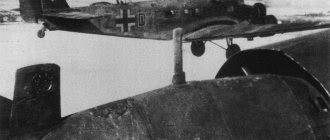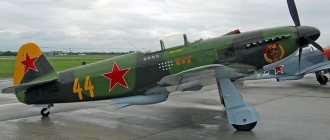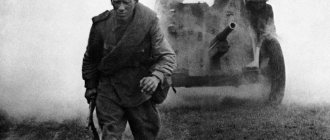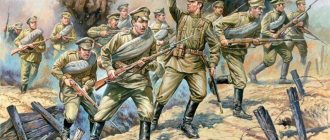Operational and strategic goal
The southern front was given the operational-strategic goal of a sudden preventive concentrated strike by the combined forces of the ground forces, aviation and navy with the widespread involvement of airborne units and naval landing forces to destroy the border opposing enemy group and carry out a rapid offensive to the west-northwest under the cover of the Carpathian mountain ranges .
The forces of the Southern Front, in operational cooperation with the ships of the Black Sea Fleet, were supposed to strike the opposing enemy with the start of hostilities against the armed forces of Romania and Germany. Having suppressed its defenses in a border battle, it was planned to simultaneously land air and sea troops on the territory of Romania and, supporting it with a rapid offensive from the front by tank corps and motorized infantry, seize the oil fields in Ploesti, depriving the main enemy - Germany of oil necessary for aviation and transport. , tank and motorized units of the Wehrmacht. Next, it was planned to advance south of the Carpathians with the simultaneous capture of the dominant heights and the most important passes with the aim of reaching southern Germany. The actions of the Southern Front were to be supported on the Danube River with access to its upper course by the Danube River Flotilla, and from the sea by an amphibious assault from ships and landing craft of the Black Sea Fleet, which was ordered to capture the port of Constanta. The reinforced 7th Rifle Corps was supposed to be used as a marine force, which carried out intensive training, including landing and disembarking from landing ships under the cover of aviation and the Operational Group of Black Sea Fleet support ships. The front's offensive was also supported by Black Sea Fleet submarines, which were supposed to conduct operational reconnaissance of the sea and coast, facilitate the landing of sabotage and reconnaissance groups on the coast in the rear of the Romanian troops, secretly mine the mouth of the Danube and exits from Romanian ports, and also impede the actions of enemy fleets. The offensive was supported by the front air force, whose primary targets were the advanced border groupings of the ground forces of Romania and Germany, the oil production and oil refining enterprises of Ploesti, the port of Constanta, and the bases of the Romanian and German aviation and navy.
The defeat of the German group during the counteroffensive
By January 1943, the Red Army managed to create an advantage in manpower and equipment in the zones of action of the Southern and Transcaucasian fronts.
Alignment of forces at the beginning of the 2nd stage of the battle
In numerical terms, the superiority was:
- in personnel by 1.4 times;
- in guns and mortars by 2.1 times;
- in tanks 1.8 times;
- in airplanes 1.7 times.
Red Army commander with his fighter
Some problems arose with the logistical support of the fronts. Firstly, difficult terrain and unstable weather. Secondly, the main routes for delivering material and personnel from the depths of the country were possible only by sea. Therefore, the main burden fell on the Caspian Flotilla and, to a lesser extent, on the Black Sea Fleet.
Both fronts had the task of encircling and not letting the enemy out of the North Caucasus and Kuban with coordinated strikes with the support of the Black Sea Fleet and two air armies. It was not possible to complete this task.
Soviet counteroffensive
The German command understood the complexity of the situation. In the Stalingrad direction, the Nazi troops suffered a crushing defeat. There was a risk of getting another encirclement of Army Group “A” in the North Caucasus direction. Therefore, the decision was made to retreat. It was planned to be carried out by a sequential withdrawal to pre-selected lines, of which there were four planned, with cover by strong rearguards (classical maneuverable defense).
At the beginning of January, parts of the Wehrmacht began to retreat. At the beginning, the situation turned out well for the Germans. They managed to significantly break away from the Soviet troops. At this stage, our command did not have a sufficient number of mobile formations that could constrain the maneuver by actions on the flanks. There were only cavalry corps, which could not cope with this task.
The Nazis managed to stay ahead of our units and formations for several days. Therefore, it was decided not to scatter forces and resources, but to concentrate on the right flank and reach possible escape routes.
In the first weeks of the persecution, Pyatigorsk, Kislovodsk, and Mineralnye Vody were liberated. On January 21, Stavropol was cleared of fascist units. And yet, pushing the enemy out of the North Caucasus was unprofitable; it had to be locked in, and our troops acted late. Under these conditions, the Northern Group of Forces of the Transcaucasian Front was reorganized on January 24 into the North Caucasus Front under the command of Lieutenant General I. I. Maslennikov.
The Red Army failed to immediately capture Bataysk and Krasnodar; the battles near Tuapse became protracted. There were not enough forces to block the Nazis' retreat to Rostov.
In the current situation, plans required adjustment. As a result, the Soviet command decided to concentrate its main efforts on preventing the enemy from retreating to Rostov, the Taman Peninsula and his retreat to Crimea through the Kerch Strait. In addition, Krasnodar had to be captured as soon as possible.
On February 14, Rostov was liberated. Almost simultaneously, to the south, our troops defeated the encircled Krasnodar enemy group and liberated the city itself.
In the skies over Kuban from April 17 to 24, the largest air battle unfolded, from which Soviet aviation emerged victorious.
Decisive battles on the Taman Peninsula
The retreat to the Taman Peninsula could not be prevented. In this sector, the front narrowed and the enemy managed to thicken the battle formations. Our troops met stubborn resistance. The Nazis concentrated a group of 400 thousand on the peninsula. They wanted to hold this bridgehead at any cost. On its territory, the Nazis erected a well-known defensive line - the “Blue Line”.
Soon the protracted Novorossiysk-Taman operation began, which became the final one in the battle for the Caucasus.
The fighting there lasted from February to October 1943. The enemy units did achieve some success here. After the start of the offensive of our troops in Ukraine in September of the same year, the Nazis managed to evacuate over two hundred thousand personnel, all horses, equipment and supplies from the Taman Peninsula to Crimea.
Infantry and tanks during the Novorossiysk-Taman operation
In early February, an assault landing was carried out south of Novorossiysk. The Marines managed to capture part of the coastal areas. Subsequently, this bridgehead will be called “Malaya Zemlya”. Fierce fighting there continued until the liberation of Novorossiysk. This only happened on September 16th.
By October 9, 1943, the Taman Peninsula was completely liberated. Thus ended the battle for the Caucasus.
A summary of this stage of the battle would be incomplete without mentioning the struggle of the partisans and local residents. The partisans carried out sabotage on enemy communications, disrupted communication lines, attacked rear columns, and together with the marines defended “Malaya Zemlya.”
Residents of the mountainous regions helped our army as guides. Maps of that time did not fully reflect mountain roads and trails. In addition, a paper map could not replace an experienced mountaineer.
After summing up the results of this great historical battle in May 1944, the medal “For the Defense of the Caucasus” was established.
Medal "For the Defense of the Caucasus"
Compound
As of 06/25/1941:
- 9th Army
- 18th Army
- 7th Rifle Corps
- 9th Special Rifle Corps
- the remaining formations and units located in the front zone.
- 48th Rifle Corps (08/22/1941 - 09/01/1941)
The front had 15 rifle, 3 cavalry, 6 tank, 3 motorized divisions. In addition, the Southern Front included four fortified regions (UR) (10, 12, 80 and 82). The Danube military flotilla, the Odessa naval base and the border detachments of the NKVD of the USSR were under his operational subordination.
Front actions
In the first weeks of the war, front troops acted against Romanian troops in a 700 km wide zone from the city of Lipcani on the Romanian border to Odessa, conducting a defensive operation in Moldova and contacting the troops of the Southwestern Front in the north. After the defeat of the main forces of the Southwestern Front near Uman and then near Kiev in July-September 1941, the command of the Southern Front organized defense in the Zaporozhye region. Front troops also delayed the advance of Wehrmacht units under the command of Manstein near Melitopol.
However, with a new enemy offensive, during the Donbass-Rostov defensive operation, the defenses of the front forces were broken through, and on October 5, the 1st Wehrmacht Tank Army reached the Sea of Azov near Berdyansk, enveloping the defending units of the two front armies from the north and cutting off their retreat to the east. As a result, the 18th Army and part of the forces of the 9th Army of the Southern Front were surrounded in the area of the village. Chernigovka and suffered heavy losses. More than 100 thousand soldiers and officers were captured. The army commander, Lieutenant General A.K. Smirnov, died. 212 tanks and 672 artillery pieces were lost. The surviving units of the front fought back east along the coast of the Sea of Azov to Taganrog (fell on October 17) and further to Rostov-on-Don (fell on November 20). However, already on November 28, 1941, as a result of a successful counter-offensive, front troops liberated Rostov again during the Rostov offensive operation, inflicting the Wehrmacht's first significant defeat on the Eastern Front.
In July 1942, after a major defeat of Soviet troops near Kharkov, Rostov-on-Don was left without an order from Headquarters, as a result of which the Southern Front was disbanded, and its units were transferred to the North Caucasus Front.
Southern Front
The Southern Front was created on June 25, 1941 based on the order of the USSR NCO dated June 23, 1941 on the basis of the Odessa Military District. The front included the 9th, 18th combined arms armies, and the 9th separate rifle corps. Later it included the 6th, 12th, 24th, 37th, 51st, 56th, 57th combined arms armies, the Primorsky Army, and the 4th Air Army. During the defensive battles of 1941, front troops, under attacks from Romanian troops, retreated first beyond the Dniester and then beyond the Dnieper, leaving the Primorsky Army in Odessa. Subsequently, front formations, in cooperation with the Southwestern Front, conducted defensive battles in the Donbass, preventing the enemy from encircling Soviet troops. The formations of Army Group South that broke through to Rostov-on-Don were thrown back during a counter-offensive operation across the Mius River. During the general offensive of the Red Army in the winter of 1942, front troops, together with the Southwestern Front, advanced 100 km. In May of the same year they took part in the battles near Kharkov, in the summer they left Donbass, Rostov-on-Don, and retreated south beyond the Don. On July 12, 1942, formations of the abolished Southwestern Front became part of the front.
Abolished on July 28, 1942 based on the directive of the Supreme Command Headquarters of July 28, 1942. Front troops were transferred to the North Caucasus Front.
Troops of the Southern Front participated in the following operations:
- Strategic Operations:
Voronezh-Voroshilovgrad strategic defensive operation of 1942;
- Donbass-Rostov strategic defensive operation of 1941;
- Kyiv strategic defensive operation of 1941;
- Lviv-Chernivtsi strategic defensive operation of 1941;
- Rostov strategic offensive operation of 1941.
- Barvenkovo-Lozovskaya offensive operation of 1942;
The Southern Front was again created on January 1, 1943 on the basis of a directive from the Supreme Command Headquarters of December 30, 1942 as a result of the renaming of the Stalingrad Front. The front included the 2nd Guards, 28th, 51st combined arms armies, and 8th Air Army. Later it included the 3rd Guards and 44th Combined Arms Armies. The Azov military flotilla was operationally subordinate. During the offensive in January - February 1943, front troops advanced 300-500 km, liberated Rostov-on-Don, and reached the Mius River. In cooperation with the Southwestern Front and during independent operations in the fall of 1943, front units liberated the Donbass, broke through the southern section of the Eastern Wall on the Molochnaya River, reached the lower reaches of the Dnieper, the Perekop Isthmus, seized a bridgehead on the southern bank of the Sivash, blocking the enemy group in the Crimea .
Renamed on October 20, 1943, based on the directive of the Supreme Command Headquarters of October 16, 1943, into the 4th Ukrainian Front.
Troops of the Southern Front participated in the following operations:
- Strategic Operations:
Donbass strategic offensive operation of 1943;
- Lower Dnieper strategic offensive operation of 1943;
- North Caucasus strategic offensive operation of 1943.
- Melitopol offensive operation of 1943;
Connections:
- July 1, 1941:
Armies:
9th Army;
- 18th Army;
- Rifle, airborne and cavalry formations:
9th Rifle Corps:
106th Infantry Division;
- 137th high-power howitzer artillery regiment RGK;
- 317th Reconnaissance Aviation Regiment;
- 19th Pontoon-Bridge Regiment.
- Armies:
9th Army;
- Rifle, airborne and cavalry formations:
136th Infantry Division;
- 4th Artillery Brigade of Anti-Tank Guns;
- 2nd Tank Brigade;
- 21st Mixed Aviation Division;
- 38th Engineer Regiment;
- Armies:
9th Army;
- Rifle, airborne and cavalry formations:
separate motorized rifle regiment (no number);
- 665th artillery regiment of anti-tank guns;
- 15th Tank Brigade;
- 22nd Bombardment Division;
4th Assault Aviation Regiment;
- 38th Engineer Regiment;
- Armies:
9th Army;
- Rifle, airborne and cavalry formations:
176th Infantry Division;
62nd Cavalry Division;
- 34th Cavalry Division;
- 26th Cavalry Division;
- 229th Artillery Regiment;
- 7th Tank Brigade;
- 21st Mixed Aviation Division;
- 38th Engineer Regiment;
- Armies:
12th Army;
- Rifle, airborne and cavalry formations:
347th Infantry Division;
- 67th Guards Mortar Regiment;
- 5th Guards Tank Brigade;
- 27th Special Purpose Engineer Brigade;
- Armies:
2nd Guards Army;
- Artillery and mortar formations:
1105th Cannon Artillery Regiment;
- 85th Tank Brigade;
- 1st Pontoon-Bridge Brigade;
- Armies:
2nd Guards Army;
- Rifle, airborne and cavalry formations:
3rd Guards Cavalry Corps:
5th Guards Cavalry Division;
- 9th Guards Cavalry Division;
- 11th Guards Cavalry Division;
- 1105th Cannon Artillery Regiment;
- 3rd Guards Mechanized Corps:
7th Guards Mechanized Brigade;
- 13th Guards Mechanized Brigade;
- 1st Pontoon-Bridge Brigade;
- Armies:
2nd Guards Army;
- Artillery and mortar formations:
8th Anti-Tank Artillery Brigade;
- 4th Guards Mechanized Corps:
13th Guards Mechanized Brigade;
- 1st Pontoon-Bridge Brigade;
- Armies:
2nd Guards Army;
- Rifle, airborne and cavalry formations:
4th Guards Cavalry Corps:
9th Guards Cavalry Division;
- 11th Guards Cavalry Division;
- 6th Anti-Tank Artillery Brigade;
- 11th Tank Corps:
20th Tank Brigade;
- 70th Tank Brigade;
- 8th Guards Tank Brigade;
- 13th Guards Mechanized Brigade;
- 2nd Pontoon-Bridge Brigade;
| Front commanders | |
| June 25, 1941 - August 30, 1941 | General of the Army I.V. Tyulenev |
| August 30, 1941 - October 5, 1941 | Lieutenant General D.I. Ryabyshev |
| October 5, 1941 - December 24, 1941 | Colonel General Ya.T. Cherevichenko |
| December 24, 1941 - July 28, 1942 | Lieutenant General R.Ya.Malinovsky |
| January 1, 1943 - February 2, 1943 | Colonel General A.I. Eremenko |
| February 2, 1943 - February 12, 1943 | Lieutenant General R.Ya.Malinovsky |
| February 12, 1943 - March 22, 1943 | Colonel General R.Ya.Malinovsky |
| March 22, 1943 - April 28, 1943 | Lieutenant General F.I. Tolbukhin |
| April 28, 1943 - September 21, 1943 | Colonel General F.I. Tolbukhin |
| September 21, 1943 - October 20, 1943 | Army General F.I. Tolbukhin |
111 views
Command
Troop commanders:
- Army General I.V. Tyulenev was initially appointed commander of the front.
- Army General I.V. Tyulenev, wounded as a result of personal participation in the attack, was replaced on August 20, 1941 by Lieutenant General D.I. Ryabyshev.
- From October 5, 1941, the front was headed by Lieutenant General Ya. T. Cherevichenko.
- From December 1941 to July 1942, Lieutenant General R. Ya. Malinovsky.
Members of the Military Council:
- Alexander Ivanovich Zaporozhets, army commissar 1st rank
- Leonid Romanovich Korniets, brigade commissar
- Zadionchenko, Semyon Borisovich
- P. G. Borodin
- Illarion Ivanovich Larin, divisional commissar
Chiefs of Staff:
- Alexey Innokentievich Antonov, Major General
Head of the Intelligence Department of the Front Headquarters:
- Alexander Filippovich Vasiliev Colonel
Formation of the group and its tasks
The formation of the southern group began with the reorganization of the 12th Army of the Wehrmacht on August 24, 1939. On 1 September 1939, she took part in the attack on Poland along with the future Army Group North, under the leadership of Colonel General von Bock. After the Polish occupation, it was transferred to the Western European theater of operations and renamed Army Group A.
On June 22, 1941, the formation was renamed again, this time to Army Group South. At this point it included:
- 6th Army Colonel General W. von Reichenau;
- 7th Army of Colonel General F. Dollmann;
- 11th Army Colonel General O. von Schobert;
- 17th Army of Infantry General K. von Stülpnagel;
- 1st Panzer Army, Colonel General E. von Kleist;
- 3rd Romanian Army under Lieutenant General P. Dumitrescu;
- 4th Romanian Army under General N. Chuperka;
- 4th Air Fleet Colonel General A. Lera.
In total, more than one and a half million people, 16 thousand guns, about two thousand aircraft and more than a thousand tanks. Field Marshal G. von Rundstedt was responsible for general leadership. The 213th, 444th and 454th German divisions provided cover for Army Group South.
According to the Barbarossa plan, the southern group was supposed to attack the Kiev Special Military District, capture Galicia, break through the Rava-Russkaya-Kovel line and move on Kyiv. After this, it was planned to turn in a southeastern direction to block the path of Soviet troops to the right bank of Ukraine.
Full list of commanders
- During World War II, Army Group South was led by:
- August 24, 1939 - December 1, 1941 - Gerd von Rundstedt;
- December 1, 1941 - January 15, 1942 - Walter von Reichenau;
- January 18, 1942 - January 18, 1943 - Feodor von Bock;
- January 18, 1943 - March 31, 1944 - Erich von Manstein;
- March 31, 1944 - April 4, 1944 - Walter Model;
- September 23, 1944 - December 22, 1944 - Johannes Friesner;
- December 28, 1944 - April 6, 1945 - Otto Wehler;
- April 6, 1945 - April 30, 1945 - Lothar Rendulic.
Second formation
The southern front of the second formation was formed on December 31, 1942 on the basis of the disbanded Stalingrad Front. The commander of the front from formation until February 1943 was Colonel General A. I. Eremenko, the chief of staff of the front from formation until April 1943 was Major General I. S. Varennikov. On January 1, 1943, the Stalingrad Front was renamed the Southern Front. In March 1943, the front was headed by Lieutenant General F.I. Tolbukhin. On October 20, 1943, the front was renamed the 4th Ukrainian Front.
The troops of the Southern Front (2nd formation) carried out the Rostov operation, the Mius operation, and the Donbass operation.
The Battle of the Caucasus 1942-1943 – a serious turning point in the course of the war
The battle for the Caucasus was of decisive importance for the outcome of the Great Patriotic War. Had the Soviet Union lost this battle, it is quite possible that the entire Second World War would have been lost. It was one of the longest and lasted from July 25, 1942 to October 9, 1943.
Time is inexorable. Today there are very few WWII veterans left - participants in that great struggle against the enemy. They try their best to surround them with care and attention, especially on the memorable dates of these events. Poems are dedicated to heroes in which their exploits are glorified. Children's drawing competitions are held on the theme of the Battle of the Caucasus, where children often depict warriors with orders and medals. These pictures once again remind us of how important it is to take care of the world.
Heroes and ordinary participants in the battle for the Caucasus can be seen in the photo on May 9 during the procession of the Immortal Regiment.
Hero of the Great Patriotic War on May 9 during the procession of the Immortal Regiment
This victory came at a huge cost to us. What we call "the battle" was in reality a series of military operations. The battle for the Caucasus has a strategic division into two stages - the first was defensive (throughout 1942), and the second offensive (from the beginning of 1943).






